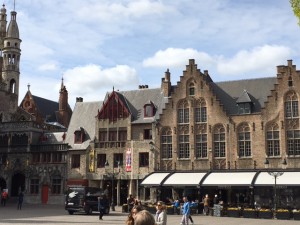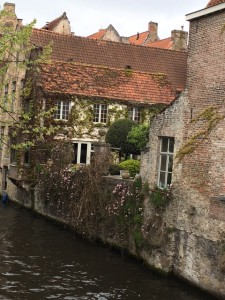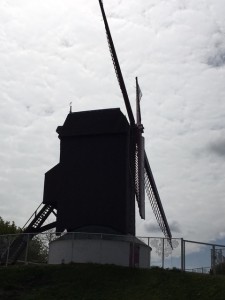In the market-place of Bruges stands the belfry old and brown;
Thrice consumed and thrice rebuilded, still it watches o’er the town…
Not a sound rose from the city at that early morning hour,
But I heard a heart of iron beating in the ancient tower.
From their nests beneath the rafters sang the swallows wild and high;
And the world, beneath me sleeping, seemed more distant than the sky.
Then most musical and solemn, bringing back the olden times,
With their strange, unearthly changes rang the melancholy chimes,
Like the psalms from some old cloister, when the nuns sing in the choir;
And the great bell tolled among them, like the chanting of a friar.
~ Henry Wadsworth Longfellow
 If you are looking for a comely city in which to wander, then I would like to recommend Bruges, or Brugge, in the northwest corner of Belgium. Last month we drove across from Luxembourg to meet up with old friends there, for a weekend, and we were utterly delighted with this charming little city.
If you are looking for a comely city in which to wander, then I would like to recommend Bruges, or Brugge, in the northwest corner of Belgium. Last month we drove across from Luxembourg to meet up with old friends there, for a weekend, and we were utterly delighted with this charming little city.
Many years ago, in early December, the One & Only and I popped over to Bruges from the UK for a romantic weekend break. The city square was clotted with Christmas stalls selling mulled wine, handcrafted Christmas decorations and Belgian chocolates. The air was crisp, almost brittle, and I remember taking a boat trip on the canal that turned my legs into two frozen tree stumps. By the time I tried to clamber out of the boat, my limbs wouldn’t function, and I was convinced I had frost bite. I staggered in geriatric fashion across a cobbled square, on the arm of my One & Only, to a cosy wine bar, where we thawed out over a bottle of warm white port.
This time, the sky was a deep, uplifting blue, the trees were blooming with verdant exuberance, and the sun was toasty warm on our arms and faces. It felt like a different city altogether.
Driving from Luxembourg, we were gobsmacked by the glorious architecture in the centre of Bruges. Luxembourg unarguably has its beauty spots. The old mediaeval town is lovely, with its Baroque ducal palace as the centrepiece. Yet beyond the UNESCO Heritage fortifications and a few elegant church spires, Luxembourg architecture becomes largely practical, pragmatic, functional, serviceable. Houses and municipal buildings are often boxy, pebble-dashed and lacking character. The Kirchberg Plateau, once covered in fields and woodland, was transformed in the 1960s. Today it is home to one of the three official capitals of the European Union and the seat of the European Court of Justice, and the plateau is covered in vast, almost Communist style office blocks; the main thoroughfare broad, straight and unromantic framed by empty, concrete plazas, and a dearth of trees.
Bruges – also a UNESCO World Heritage Site and approximately the same size as Luxembourg – is, in comparison, dulcet, leafy, enchanting. It is like walking through a fairy tale. The picturesque architecture makes your heart melt, and the winding, cobbled streets and hidden squares are chock-a-block with restaurant tables donned in white linen or red and white checked table cloths. Church spires and towers aspire to tickle the clouds, while market stalls clamber for space on the pavements. One craft market has even taken over the old fish market with its broad stone counters. The architecture – traditional Flemish – is reminiscent of Amsterdam, with its tall, narrow buildings, stepped gables and steep, peaked roofs lining canals stippled with swans. Pretty houses lean over the edge of the canals, like Narcissus, to admire their own alluring reflections in the water. My friend and I claimed the loveliest for ourselves, and dreamed of one day being neighbours in various wisteria-clad stone houses with their small, neat, walled gardens.
The picturesque architecture makes your heart melt, and the winding, cobbled streets and hidden squares are chock-a-block with restaurant tables donned in white linen or red and white checked table cloths. Church spires and towers aspire to tickle the clouds, while market stalls clamber for space on the pavements. One craft market has even taken over the old fish market with its broad stone counters. The architecture – traditional Flemish – is reminiscent of Amsterdam, with its tall, narrow buildings, stepped gables and steep, peaked roofs lining canals stippled with swans. Pretty houses lean over the edge of the canals, like Narcissus, to admire their own alluring reflections in the water. My friend and I claimed the loveliest for ourselves, and dreamed of one day being neighbours in various wisteria-clad stone houses with their small, neat, walled gardens.
Strategically situated at the crossroads of north and south trade routes, Bruges became a wealthy trading centre from the 12th to the 15th centuries renowned for its Portuguese spices, British and Castilian wool, glorious weaving and successful banks. Unfortunately, natural silting in the river brought an end to the city’s prominence as a trading port in the 15th century, and its prime position was usurped by Antwerp. It sunk into insignificance until the second half of the nineteenth century, when appreciative British and French visitors began to flock to this bewitching city.
Fortunately, Bruges suffered almost no damage during either of the world wars, and in the 1960s, the mediaeval city centre was overhauled, experiencing a renaissance that brought a surge of tourists that would increase significantly over the next fifty years.
Despite the crush of early summer tourists, the city is calm and peaceful: canals encircle the city like a giant moat, fringed in lush trees and gardens. The restaurants fill quickly at meal times, but we can still garner a table without too much effort when we get hungry. Everyone serves mussels (the city’s favourite dish?) and while the food is not spectacular, for a town dominated by the ever-flighty tourist trade, it’s tasty and generous. When we tired a little of mussels, we even found an excellent Thai restaurant! The town, heavily reliant on tourism, somehow manages the annual influx better than most. Our friends are staying in a terribly posh hotel and we gawp at its glamour. The Duke’s Palace is a 15th-century palace with lavish rooms, stained glass and fairy tale turrets tucked away off Noordzandstraat, one of the main shopping streets. We found a quaint, and slightly cheaper little spot just around the corner on Kopstraat, where we received a warm and wonderful welcome from the Dutch manager. The Grand Hotel Sablon is more down-to-earth than its title would suggest, with high ceilings and a homely, shabby-chic touch to its décor. It also served one of the best breakfasts I have ever wolfed down. Both hotels were right in the heart of the city, a mere skip and a jump from the main square, the cafes, museums, shops and galleries.
 As we only had a couple of days, we generally avoided the tourist highlights, preferring to meander through the narrow back streets, admiring the gorgeous buildings, drifting along the canals, nibbling the odd chocolate and getting comfortable with the place. Spiralling out to the edge of town, we found four eighteenth century windmills (once twenty-seven) standing guard like blousy sentinels. They have been carefully restored, one apparently is now a museum. On Sunday morning we got up and out early, and strolled to the canal, through Smedenpoort, one of the original 14th century city gates, and along the banks of the canal that wraps around the city. On the way, we pointed out a profusion of stepped roof lines, wisteria dripping in grape-like profusion over stone walls, little motorboats ducking beneath the low-slung, hump-backed bridges, an enclave of swans snuggling on the river banks.
As we only had a couple of days, we generally avoided the tourist highlights, preferring to meander through the narrow back streets, admiring the gorgeous buildings, drifting along the canals, nibbling the odd chocolate and getting comfortable with the place. Spiralling out to the edge of town, we found four eighteenth century windmills (once twenty-seven) standing guard like blousy sentinels. They have been carefully restored, one apparently is now a museum. On Sunday morning we got up and out early, and strolled to the canal, through Smedenpoort, one of the original 14th century city gates, and along the banks of the canal that wraps around the city. On the way, we pointed out a profusion of stepped roof lines, wisteria dripping in grape-like profusion over stone walls, little motorboats ducking beneath the low-slung, hump-backed bridges, an enclave of swans snuggling on the river banks.
A three-arched, hump-backed bridge led us through a narrow, heavy wooden gate into the grounds of the beguinage, a Benedictine convent that was built for a community of pious women in 1244. We found ourselves in a quiet courtyard filled with the last of the spring daffodils, and surrounded by neat white houses. It seemed to embody the tranquillity, the serenity that overlays the entire city.
And as in the poem, our days were marked by the stolid, steady bells of Belfort, a 13th-century belfry with a 47-bell carillon and 83 metre tall tower in Markt square. Ringing out on the hour, every hour, the bells will apparently warn of fire or enemies approaching. Truly, a ‘strange, unearthly sound,’ yet somehow calling you out, irresistibly, to explore this delicious city.
